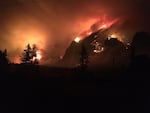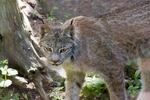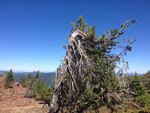
The Eagle Creek Fire spread through the Columbia River Gorge, September 4, 2017.
Courtesy of InciWeb
As wildfires rage across the Pacific Northwest, more than just people are displaced from their homes. Animals in the wild are also feeling the effects of the flames.
More and more, wildfires are changing conservation strategies for threatened and endangered animals in the region, especially as a warming climate lengthens fire season.
“We essentially assume that we’re going to have earlier fire seasons. They’re going to last longer. And they will typically be more severe,” said Jeff Krupka, field office manager for the U.S. Fish and Wildlife Service in Central Washington.
Northern spotted owl, Canada lynx, bull trout. Just a few in a long line of listed animals. Not to mention rare and endangered plants.

Canada lynx
rfzappala/Flickr
It's still too early to know what species are threatened by the Eagle Creek Fire in the Columbia River Gorge, as firefighters are working to save people and homes.
But resilient ecosystems have a better ability to recover from natural disasters, said Rachel Pawlitz, U.S. Forest Service spokeswoman.
"We believe we've taken good care of the underlying ecology of this area in the last 30 years since we were created," she said. "That will be a factor to help the natural system regenerate itself."
Pawlitz said, although many people want to help, it's important that they don't take a go-it-alone approach with restoration efforts. Volunteers should work with the Forest Service or other experts once the fire is out.
A fire earlier this summer near Quincy, Washington, swept through pygmy rabbit habitat. The rabbits are federally listed as endangered in the state — the hilly sagebrush landscape in Central Washington is their only home.
Biologists have worked since 2011 to breed and release hundreds of the palm-sized rabbits into the wild. They say the program has been a success.

Biologists are now trying to breed pygmy rabbits in the wild. So far biologists have found around 90 burrows this winter. Penny Becker says the DNA samples have shown more than 40 individual rabbits.
Flickr Creative Commons: USFWS Pacific
But this June, the wind-driven Sutherland Canyon Fire killed about 70 rabbits in one breeding area. Biologists and firefighters were able to rescue 32 others that had escaped into burrows.
Matt Monda, Washington Department of Fish and Wildlife regional wildlife manager, said many of the surviving rabbits were found the next day, huddled in a small patch of sagebrush surrounded by charred landscape.
Lead biologist Jon Gallie had retrofitted the irrigation system to keep that patch alive.
"The fire was a setback for our restoration program, but we can start making up for those losses next year," Monda said. "Wildfires are a fact of life here in sagebrush country, which is a major reason why we don't keep all of the rabbits in one place."

Whitebark pines thrive in rugged mountain in environments.
Devan Schwartz / OPB
Right now, the Jolly Mountain Fire is threatening spotted owl, bull trout, and steelhead habitat. It’s also burning near
, which the U.S. Forest Service says needs protection but is not yet listed on the Endangered Species List.
Farther north in Washington, there's concern for what's left of Canada lynx habitat. The Diamond Creek Fire, which is still burning in Okanogan County, may have destroyed what's left of the federally threatened wildcats' habitat.
“That’s particularly disheartening because in the state of Washington, we have essentially one reproductive population of lynx, and that’s where they live,” Krupka said.
Lynx resemble bobcats with very furry paws and short tails. One resident population is known to live in Washington. The federal and state government designated critical habitat in Okanogan County.
"The Okanogan Lynx Management Zone has taken a beating in the last decade (because of fires)," Krupka said.
Habitat fragmentation from wildfires, along with climate change, are considered the biggest threats to lynx in the state.
Conservation groups threatened to sue the U.S. Fish and Wildlife Service because they were concerned there wasn't enough lynx habitat set aside in the state.
Managers will be better able to assess damage once the fires are put out — and it’s safe for people to survey habitat areas.
But it’s not all bad — wildfires are a natural part of the landscape. Some animals may even thrive after a fire, said Michelle Dennehy, Oregon Department of Fish and Wildlife spokeswoman.
“Some animals will perish in the fire, some will evade it, but for the most part, populations will not be impacted long-term. In fact, some populations may flourish and exceed pre-fire numbers with the positive ecological functions following a fire,” Dennehy said in an email.
She said most habitats require disturbance, like fires and floods, and without these periodic events the land really isn't as good as it could be.
"Animals rely on a mosaic of habitats to complete their needs…. and the disturbance related habitat created by the fire, once recovered, will add to habitat complexity and provide a new type of habitat," Dennehy said.
In Oregon, the Eagle Creek Fire forced ODFW to prematurely release 606,000 fall chinook salmon from fish hatcheries in the Columbia River Gorge.
Hatchery managers had marked and tagged the early releases, so they will be able to track and compare their survival rates.
Those fish are expected to do OK.
Looking ahead, there could be more concerns for other fish, including threatened and endangered salmon and bull trout.
If riparian areas on stream edges have been damaged, water temperatures could get warmer near spawning areas.
Fires often disturb the ground as well. There’s no vegetation left to hold in the soil — and so heavy rains could cause mudslides or excessive sediment in streams.
A silver lining: fallen trees could become good fish habitat later, Dennehy said.
Many animals that are able to move quickly will do so, said Ross Huffman, southcentral regional lands operations manager for WDFW.
“It depends on the species. Things like wolves are pretty highly mobile, as long as the fire’s not going super fast or has a really strong wind. They more than likely have the ability to escape, as long as there’s habitat nearby that they can move to. Spotted owls are highly mobile. The longer term (problem) would be the loss of habitat,” Huffman said.
Looking forward, once more is known about what has really been lost, land managers are thinking about restoration efforts: stabilizing loose sediment, repairing roads, restoring trees and aquatic habitats.
And they begin to ask what else can be done. Should land managers do more?
Take the Canada lynx, Krupka said. Should they put in pre-suppression fire lines in the subalpine habitat? It's not something that's normally thought about.
“When you have a limited resource is that something that you should do?” Krupka said. “We ask these questions of ourselves, unfortunately sometimes after a tragedy of sorts. What can we learn from this? What can we do better?”
